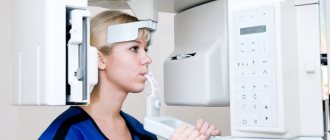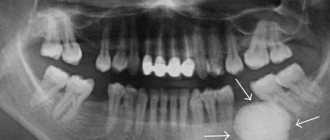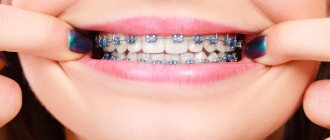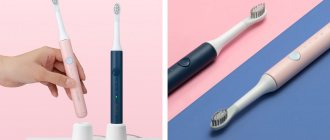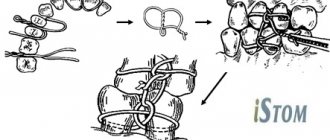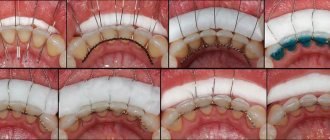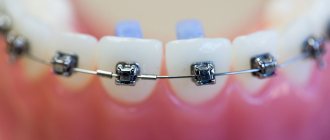Dental parallelometers
A dental laboratory uses equipment for cutting, grinding, sintering and fixing dentures, but without measuring instruments it is impossible to produce high-quality and comfortable dentures of the correct shape. A parallelometer is a device designed to determine undercuts and parallelism of the walls of abutment teeth, as well as to draw a survey line.
The device allows you to create artificial parallelism of teeth, choose the optimal direction for inserting the prosthesis and ensure reliable fixation of the clasps.
Parallelometry in prosthetic dentistry
In dentistry (namely in orthopedic dentistry) it is customary to use a definition such as parallelometry. This is a scientific branch that studies the parallelism of the axial points of supporting dental elements.
This knowledge is used when it is necessary to produce high-quality dentures.
If the prosthetic structure consists of several clasps characterized by retention functionality, then the correct location of the clasp arms at the retention points is necessary.
Such manipulations are necessary for fastening the denture so that the clasps that perform the supporting function cannot loosen the dental elements at the supporting points. Thus, there is an even distribution of pressure throughout all dentures during the chewing process.
Parallelometry in prosthetic dentistry
How is the equipment used?
To determine the exact parallelism of dental elements, a special device is used - a parallelometer. It is also used to determine the parallelism of different parts of the modeled jaw.
The operation of this device is based on the fact that when the rod is displaced, it will always be parallel to the original position. The dental parallelometer is a fairly simple device in design and consists of several parts.
Reference! A parallelometer is a dental device that measures the exact parallelism of the supporting walls of dental elements. Consequently, the prosthesis is provided with reliable fixation, as well as trouble-free insertion and removal into or out of the oral cavity.
The sequence of determining the general equator line of the supporting teeth by the angle of inclination of their longitudinal axes
Structural elements of a parallelometer
Device elementBrief characteristics
| Kernel | These elements are always fixed vertically and are characterized by a perpendicular location. Movement occurs exclusively up or down or horizontally |
| Table | This is the working part that is placed directly on the platform. The checking manipulation to determine the parallelism of the manufactured jaw occurs precisely when it is placed on the table |
| Table leg | Thanks to the leg (bracket), the table is attached to the platform. Its position can be adjusted both in height and inclination |
Dental apparatus parallelometer
The design of modern devices includes several rods, each of which is equipped with the following auxiliary elements:
- an analyzing rod with a special disk is responsible for measuring actions and identifying possible friction;
- The graphite rod has a blade (removes excess wax) and does the delineation of the belt line.
Jaw making process
The first manufacturing manipulation involves a detailed study of the model. The jaw model is cast only from high quality plaster. Then the resulting model is thoroughly dried and inspected for the presence of excesses; if any are present, they are carefully cut off.
The jaw base should not be less than one and a half centimeters. The side walls of the model are always made parallel to each other in relation, but perpendicular in relation to the jaw base.
Attention! The manufacturing process of clasp dentures includes parallelometric manipulations. This is a mandatory manipulation to create various models of prostheses.
You can clearly get acquainted with the working aspects of making dentures using the example of clasp dentures by watching the video.
Measuring parallelometer gauges
By using the above gauges, the location of the ends of the clasp arms, which are responsible for the holding function, is determined. Marks are made in different colors near the supporting dental elements.
To determine the point beginning of the pattern of the fixing bracket of the supporting dental element, it is necessary to connect a certain caliber, and not a rod.
Then, by moving the gauge up and down, the location is determined where the dental element simultaneously touches the rod and the gauge.
From this point the clasp pattern begins (it should be applied so that a quarter of the clasp arm is located below the dental belt).
Once the drawing is ready, you should outline the arcs and remaining elements of the simulated prosthesis with a pencil. Then you need to fill the retention areas with wax. After they harden, excess wax is removed using a blade.
Parallelometry problems
The process of work done on the modeled jaw is completed by recreating the exact parallelism of the dental elements. Next, a dental prosthesis is made using the manufactured model.
Parallelometry is the basis when treating a patient with dentures, and various fixation elements are used.
Thus, it is possible to avoid the problems of introducing or removing finished dentures from the oral cavity, because thanks to parallelometry, isolation is created, which prevents the occurrence of seizures of the base part.
Therefore, when manufacturing and preliminary modeling a model of a prosthesis, it is imperative to use a measuring device - a parallelometer, to avoid asymmetry of the finished denture.
Source: https://expertdent.net/protezirovanie-zubov/byugelnyie-zubnyie-protezyi/parallelometriya-v-ortopedicheskoy-stomatologii.html
What does the device look like?
Modern equipment for measuring parallelism is installed on dental milling machines, which significantly increases the quality and accuracy of milling work. The cost of the device depends on the manufacturing company, ergonomics, functional equipment, and year of manufacture.
The device consists of a stand with a movable bracket, on which instruments for measuring dentures and cutting wax are mounted, and a flat working surface. There are several configuration options: with a movable clamp, a movable table, a fixed stand connected to the frame.
For convenient work with models, a replaceable set of rods is provided. The following types of rods are distinguished:
- to determine the survey line;
- for measuring work;
- for drawing survey lines;
- blades for cutting off excess wax.
The device body is assembled from aluminum parts. This approach allows us to achieve the necessary margin of strength and wear resistance, while ensuring low weight. Polymer spray coating provides electrostatic protection.
Dentures
PARALLELOMETERS.
TYPES AND DEVICES The use of the first devices for parallelometry dates back to the end of the 19th - beginning of the 20th century. During this period, various designs of bridges on screw-in and removable crowns, removable pin teeth, rings on crowns with spring protrusions, locking connections and other supports became widespread.
The manufacture of these structures required high precision and parallelism of the supporting parts, which, apparently, contributed to the creation of parallelometer devices. Already in the 20s of the 20th century, parallelometers appeared for bridge work by Sixt, Ney, and others, which were used to identify parallel areas on abutment teeth, accurately prepare proximal walls, adjust and parallel install inlays, locking fastenings and other support systems.
During the same period, support-retaining clasps for fixing removable bridges (Nesbett, Acker, etc.), as well as removable bridges with a clasp, simultaneously restoring several defects in the dentition, became widespread. This served as an impetus for further improvement of parallelometers and expansion of indications for their use.
the structure of parallelometers used in the manufacture of bridges and graphite pins. According to J. M. Ney [cit. according to E. Kennedy, 1942], the first specialist to evaluate the feasibility of using technical devices for accurately drawing the clasp line was the doctor Fortunati. In 1918
He demonstrated in Boston a method of using a parallelometer for bridge work, in which for the first time a hollow metal rod with a graphite core was installed, with which the equator of the abutment teeth was outlined. Subsequently, similar devices, called clasp markers, or clasp markers, found widespread use in the manufacture of clasp dentures (Fig. 2).
At the same time, devices for the manufacture of bridge structures were also gradually improved. Miniature intraoral devices have appeared that are attached to the teeth and ensure their preparation and the achievement of parallelism between the walls of the teeth, root canals and cavities for inlays. Some of them were later transformed into microparallelometers.
Interest in the issues of preliminary calculation of structures and measurement of parallelism of teeth has especially increased with the advent of steel alloys for casting dentures and their parts. The use of steels opened up prospects for mass and relatively inexpensive prosthetics. However, the use of these alloys for the manufacture of solid-cast clasp dentures was hampered for a long time due to the lack of effective sources for melting refractory steels and significant shrinkage of cast frames.
This was no less hampered by numerous failures associated with inaccurate manufacturing of structures. Thus, arbitrary modeling of clasp frames, without special measurements and calculations on the supporting teeth, inevitably required complex and time-consuming adjustment of castings both on the model and in the oral cavity.
Unreasonable selection and inaccurate placement of the supporting and holding elements of the clasp frames also led to numerous errors, which, however, were most often associated with shrinkage of the castings. The improvement of casting technology, the development of high-strength steel alloys and methods for reducing their shrinkage served as the basis for the analysis and revision of the reasons causing
Rice. 2. Scheme of the clasp device.
these errors and difficult fitting of solid frames. In turn, this contributed to the further improvement of parallelometers and the development of methods that allow preliminary calculations, as well as a thorough analysis and assessment of the remaining teeth on the jaw, taking into account their spatial movement and tilts, which increase non-parallelism. The development of the theory of parallelometry and the first scientifically based techniques is associated with research
B. Novak (1955), G. L, Roth (1942), J. M. Ney Company (1949, 1965).
Much credit for the further development of the theory and practice of parallelometry and the creation of original domestic parallelometers belongs to A. P. Grozovsky (1946), V. Yu. Kurlyandsky, V. D. Shorin and
A. A. Gremyakina (1962), E. I. Gavrilov, L. B. Malkov and M. A. Elgard (1966), G. P. Sosnin (1966, 1971, 1981), A. A. Doronin (1968), S. D. Schwartz (1968),
S. D. Schwartz and A. Ya-Tsodikovich (1968), V. A. Shcherbakov (1971), Ya-M-Lipovetsky and I. M. Lipovetsky (1971), V. V. Svirin (1972), E I. Gavrilov (1973), L. M. Perzashkevich, I. M. Strekalova, D. N. Lipshits and A. V. Ivanov (1974), V. I. Kulazhenko and S. S. Berezovsky (1975 ), N.V. Kalinina and V.V. Svirin (1976), V.N. Kopeikin, E.M. Lyubarsky, V.Yu. Kurlyandsky, S.M. Eidinov and I.V. Igonkin (1976) ,
V. N. Kopeikin (1977), V. P. Panchokha (1981), E. Ya. Vares (1979), V. Yu. Milikevich and Ya. V. Klyachko (1986), etc.
According to E.M. Gavrilov (1973), the design of parallelometers is based on the same principle: with any displacement, the vertical rod is always parallel to its original position, which makes it possible to find points on the teeth located in parallel vertical planes. V.I. Kulazhenko and S.S. Berezovsky (1975) believe that parallelometers are based on the principle of parallelism of perpendiculars lowered onto a plane.
The concept of “parallelometer” has different interpretations. S. D. Schwartz (1972) characterizes it as a marker that serves to determine the greatest convexity of a tooth at a given inclination and the relative parallelism of two or more tooth surfaces. V.V. Svirin (1972) defines a parallelometer as a device for determining the relative parallelism of abutment teeth. E.I.
We invite you to read: Metrogyl denta application in dentistry
Gavrilov (1973) also characterizes a parallelometer as a device for determining the relative parallelism of the surfaces of two or more teeth or other parts of the jaw. L. I. Perzashkevich et al. (1974) define a parallelometer as an analytical marking tool, the use of which is necessary for the manufacture of a solid-cast frame of a clasp prosthesis. V. S. Pogodin and V. A.
Currently, more than 55 designs of parallelometers are known, with the help of which the same type of problems are mainly solved, mainly related to the calculation and design of clasp and splinting prostheses. There is currently no unified classification of parallelometer types. Some authors propose to distinguish between two groups of parallelometers, based on the design features of the horizontal bracket and the presence of a removable or non-removable table.
And, indeed, in the design of parallelometers developed by S. D. Schwartz and A. Ya. Tsodikovich, Torit, Wills, A.D. Rebossio, Crupp company, VG-3 Degussa company, JM Ney Company, JF Jelenko Company, etc., a horizontal bracket mounted on a vertical post can move along it only in the vertical direction, and in some designs it can also rotate around its base.
In the designs of parallelometers developed by V. Yu. Kurlyandsky, V. D. Shorin and A. A. Gremyakina; V. N. Kopeikin, E. M. Lyubarsky, V. Yu. Kurlyandsky, S. M. Eidinov and I. V. Igonkin; E. M. Gavrilov, L. B. Malkov and M. A. Elgard;
Y. M. Lipovetsky and I. M. Lipovetsky; Williams, Bach-man, Dee, etc., a bracket with replaceable accessories can both move vertically and rotate around its axis, which provides it with greater freedom of movement compared to designs of the first group. The parallelometer table in these structures is inseparable from their base.
In our opinion, a more accurate classification is one that reflects the purpose of the device, the principle of its operation and the method of solving the tasks. The above classification also did not include fundamentally new designs—microparallelometers designed to work directly in the oral cavity.
Also not taken into account are various designs and devices for applying wax and blocking undercuts, parallel installation of stylets or pins in casts when making dismountable models, high-precision fitting and installation of anchor systems and other devices developed by Bremer Gold-schlagerei Wilg. Herbst, Crupp (Germany), Cendres Metaux SA (Switzerland), Zlatarna-Celje (Yugoslavia), Kabo group (Germany). JF Jelenko Company (USA), etc.
It should also be noted that in recent years in the USSR, Germany, the USA, Switzerland and other countries, in the manufacture of solid structures, portable milling units for dental work have become increasingly widespread. Their design is in many ways reminiscent of a parallelometer. They are equipped with a high-speed micromotor and a rotary table.
The units are used for milling T-shaped and rectangular grooves, processing cavities and edges, eliminating deviations from parallelism and obtaining surfaces with a planned geometic shape when fitting and assembling prosthetic parts. The presence of a rotary table allows milling to be carried out taking into account the insertion path chosen during parallelometry prosthesis.
Where to buy an inexpensive parallelometer
Finding a cheap dental device is not an easy task. Dental equipment is expensive, as it belongs to the category of complex equipment. If you do not want to overpay, we recommend purchasing a working used device. You can find suitable equipment for a dental laboratory on the pages of the BiMedis service, a leading online platform for the purchase and sale of medical equipment.
BiMedis has brought together sellers and buyers from all over the world. Anyone can post a sale advertisement: both legal entities and individuals. To choose the option that best suits your budget, use a special filter. The system allows you to sort search results by the following criteria: price, year of manufacture, product location, type (new, used, refurbished), device model. It is possible to exchange personal messages to agree on the details of the transaction.
If you want to sell medical equipment, post your own ad! The feature is provided free of charge.
PURPOSE
• The plane of the base of the device and the horizontal part of the movable part of the stand are parallel to each other, therefore any diagnostic rod fixed plumbly on it is perpendicular to the base of the parallelometer. The table for securing the model has a movable stand with a fixing device, which allows you to give the model any position relative to the diagnostic metal rod and other tools. Consequently, a parallelometer is a device for determining points parallel to each other and located in the same plane on an infinite number of horizontal surfaces of teeth, alveolar processes of the jaws at a certain specified position of the model in relation to the diagnostic rod (vertical). Five positions of the model in relation to the vertical diagnostic rod are practically significant (Fig. 126):
